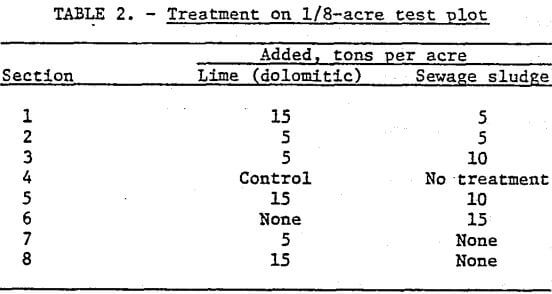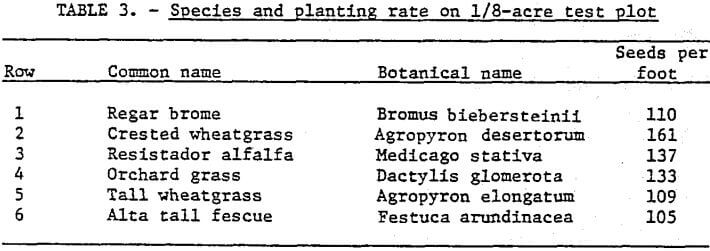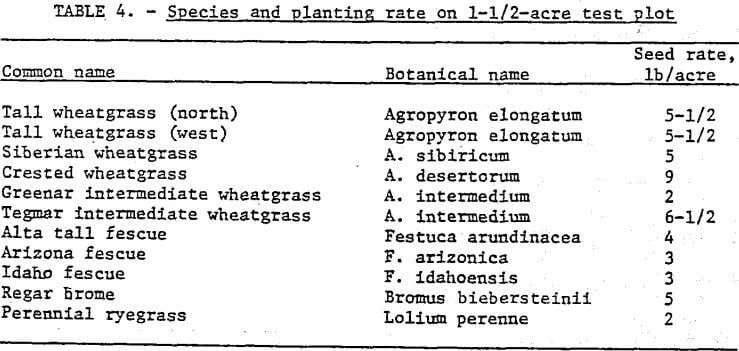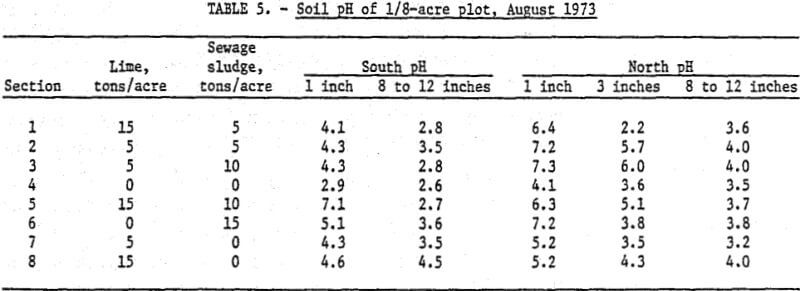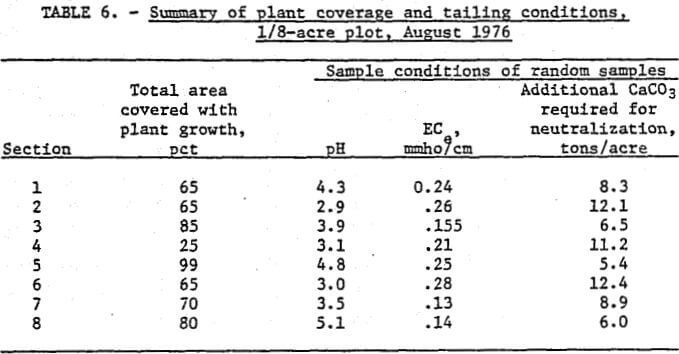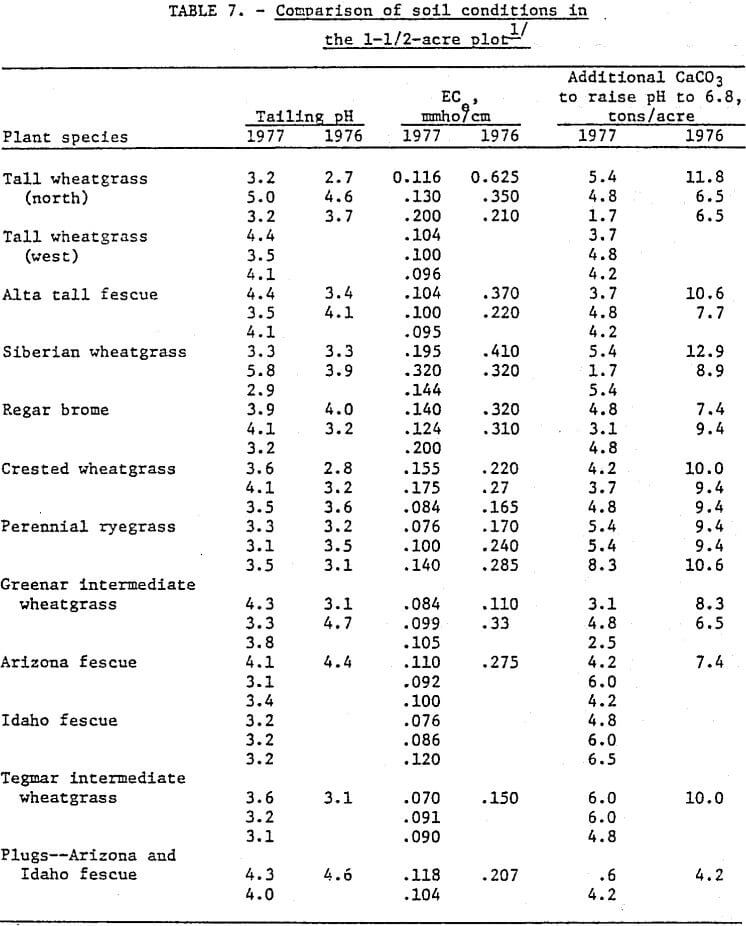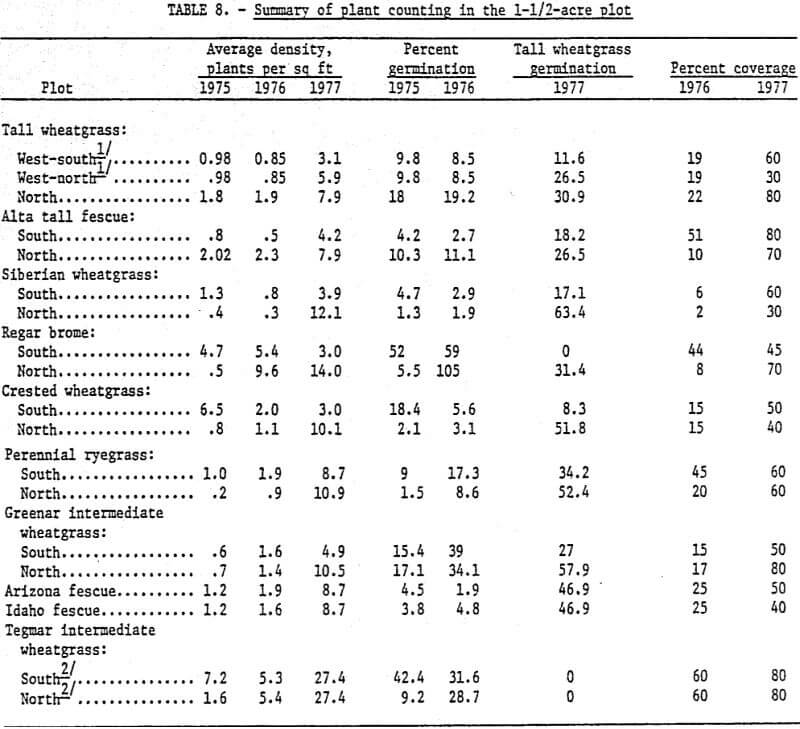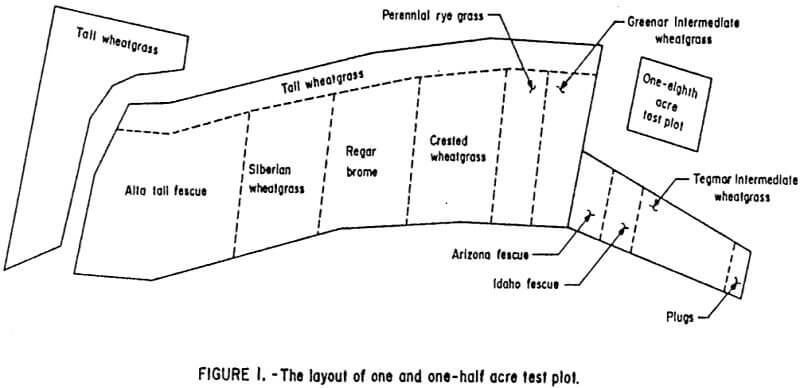Table of Contents
Field tests on 20-year-old acidic copper tailing showed that after treatment with combinations of dolomitic lime, limerock, fertilizers, and/or sewage sludge, vegetation can be successfully established. Plant coverages, 4 years after seeding, ranged from 30 to 80 percent, even though neutralization of the acidic tailing with either lime or limerock was only partially effective.
Chemical stabilization was necessary to protect both seedling and transplants until they become established. A plugged section was not chemically stabilized, and 15 percent of the plants were lost due to wind erosion. Plants started from plugs were healthier than seeded plants of the same species. Plant growth from seeding was slow, and the plants did not fully mature until the third growing season.
In seeded plots, Regar brome and Tegmar intermediate wheatgrass grew best. Of the 11 species tested, only the Siberian wheatgrass and cicer milkvetch failed to germinate.
Some plant growth did not correlate with tailing pH, as excellent growth was observed in areas with a pH of 5.8 as well as areas with a pH as low as 3.1.
The U.S. Department of the Interior, Bureau of Mines, conducted field tests on acidic copper tailing as part of its program to devise, improve, and demonstrate technology for stabilizing mining and mineral processing wastes. Results will be presented from successful 1/8-acre and 1½-acre demonstration revegetation plots established in 1973 and 1974 on an abandoned copper tailing pond located on public land adjacent to Holden Village, Wash. The tailing was neutralized with treatments of either dolomitic lime or limerock and fertilized with processed sewage sludge and/or commercial fertilizer. Plant growth covering 60 percent of the surface was achieved on both test plots. Regar brome, Tegmar intermediate wheatgrass, and tall wheatgrass provided the best plant growth and surface,coverage. In neutralizing the tailing, the target pH of 6.8 was not achieved; however, good plant growth occurred in areas where the pH ranged from 2.9 to 5.8.
In the United States, the mining sector of the economy generates more than 2 billion tons per year of mine and mill wastes that cover about 200 000 acres per year of land. Mill tailing accounts for about 30 weight-percent of these wastes and covers about 13 percent of the lands utilized. Unless stabilized, these fine-sized materials are prone to wind and water erosion. Part of the U.S. Department of the Interior, Bureau of Mines research program is to devise methods that can minimize the undesirable environmental conflicts, impacts, and occupational hazards associated with mining and processing operations while insuring that an adequate supply of minerals is maintained to meet the Nation’s demands. Therefore, the Bureau’s Salt Lake City Research Center began investigations on stabilization of mining and minerals processing wastes, and as early as 1969 reported on methods for their utilization and stabilization. Through this research the Bureau of Mines has demonstrated physical, chemical, and vegetative methods for stabilizing tailing ponds.
One of the greatest problems in stabilization is revegetation of acidic or potentially acidic tailing. This paper is an updated report of the successful vegetation field tests on acid copper tailings located at Holden Village, Chelan County, Wash.
Site Description and Climate
Field test sites were established on one of three abandoned tailing ponds located adjacent to Holden Village, Wash., on public lands managed by the U.S. Department of Agriculture, Forest Service. These tailing ponds contain most of the residues from the 10 million tons of copper sulfide ore mined and processed by the Howe Sound Co. from 1938 to 1957. The tailing ponds cover approximately 80 acres and averages 120 feet in depth. Railroad Creek runs for 4500 feet adjacent to the embankments of the three tailing ponds. Copper Creek runs between tailing ponds 1 and 2 and converges with Railroad Creek. High water in either creek can erode these tailing ponds and eventually carry this material 12 miles downstream to Lake Chelan.
The elevation at Holden Village is 3436 feet. The climate of the area is influenced by its location on the eastern slope of the Cascade Mountains, its distance and direction from the Pacific Ocean, and the prevailing westerly winds. Afternoon summer temperatures are typically in the 70° F range, but on occasion they reach the upper 80° F range. Nighttime summer temperatures are in the 40° F range. Winter temperatures usually vary between 15° F at night and 30° F during the day; readings below minus 10° F can be expected on about 10 nights a year. Holden Village receives an average of 35 inches of precipitation annually; however, most of this falls as snow between November and March. The growing seasons are dry, receiving only about 4 inches of rain, and there are droughts as long as 6 weeks. Winds in the narrow canyon frequently exceed 80 miles per hour.
Characterization of Tailing
In 1970, in cooperation with and at the request of the Forest Service, the Bureau of Mines began laboratory testing that led to stabilization field trials. The methods of stabilization used in the field tests included vegetative and chemical-vegetation procedures. The tailing is representative of an aged, abandoned copper tailing in which pyrite has oxidized to produce sulfuric acid.
Analysis of the tailing samples showed an average pH of 2.2 and an average electrical conductivity (ECe) of the saturated soil extract of 1.1 millimhos per centimeter. The amount of lime required to neutralize the tailing was determined by a triethanolamine (TEA) buffer method described by Shoemaker and others. TEA tests showed that 12.1 tons of pure CaCO3 per acre were required to raise the pH of the top 6 inches of tailing to the agricultural standard of 6.8. Results of greenhouse studies agreed with the TEA tests. Raising the pH from 2.2 to 6.8 lowered the concentration of dissolved salts and the EC . Table 1 summarizes analyses of typical unneutralized and neutralized samples.
Field Test Procedures
Samples of surface tailing received in 1970 were analyzed and used in greenhouse tests to compare the growth of six plant species in untreated tailing and tailing treated with sewage sludge, lime, and fertilizers. An initial small (1/8- acre) test plot was established on the site in May 1973; this was followed by a larger (1½- acre) plot in June 1974. The relatively isolated location of the tailing required either air or water transport (via Lake Chelan) of materials; therefore the acreages treated were limited.
The 1/8-acre plot was divided into eight sections and alined in a crosswind north-south direction. Dolomitic lime and sewage sludge were applied at rates between 0 and 15 tons per acre as indicated in table 2. One objective was to compare the effects of mixing the sewage sludge into the surface layer or leaving it on the surface; therefore, the sewage sludge was mixed by rototilling only the southern half of the plot. Ammonium nitrate at 60 pounds per acre and treble superphosphate at 100 pounds per acre were broad-cast and left on the surface of the plot. In each section, six seed species were planted in separate rows in the bottom of 2- to 3-inch-deep furrows. The seed species and their planting rates (expressed as number of seeds per lineal foot) are given in table 3.
The objectives of the 1½-acre plot were to test additional plane species for growth in neutralized tailing and to compare the growth of plugs (established plants in 2¼-inch peat pots) with the growth of plants from seed.
The test plot was neutralized by broadcasting 22 tons of minus 3/8-inch plus 10-mesh limerock per acre (the equivalent of 12 tons of calcium carbonate per acre as indicated by the TEA buffer test and as used in greenhouse tests). The area was fertilized with 124 pounds of nitrogen per acre as Nitroform and 62 pounds of phosphate per acre as treble superphosphate. After the fertilizer and limerock were spread, the test area was cultivated with a 4-foot offset disk.
The 1½ acres were divided into 11 sections, as depicted in figure 1, and each section was broadcast seeded with one of the plant species listed in table 4.
In addition, Lutana cicer milkvetch, Astragalus cicer, was broadcast over all sections at a rate of 3½ pounds per acre. After seeding, the tailing surface was smoothed and compacted by rolling.
A small section next to the seeded sections was planted with 120 Alta tall fescue and 44 Arizona fescue plants growing in 2-¼-inch peat pots. Finally, the surface, except for the section with transplants, was chemically stabilized to reduce the amount of blowing tailing that often damage or kill seedlings. Ten candidate chemicals were tested in the laboratory on tailing samples. The two with the highest surface crust strength were Crust 500 (a vinyl polymer from the Firewater Co.) and DCA-70 (an elastomeric vinyl polymer from the Onion Carbide Corp.); therefore, these two were selected for field testing. A 10-percent solution of each chemical was sprayed over a separate half of the test area at an application rate of 91 gallons of chemical per acre.
Evaluation of Field Tests
The 1/8-acre plot was examined 3 months after planting in 1973 and then annually through 1977. After 3 months, the wind had moved appreciable amounts of the treated and untreated tailing from section 1 toward section 8 (see table 2 and 3 for treatments); however, good plant growth had occurred in several sections, and the hardiest plants had 8 to 10 inches of roots and shoots. A true correlation of plant growth with lime and sewage sludge treatment could not be achieved because the wind had transported and mixed some of the amendments. However, in general, the addition of both lime and sewage sludge did appear to be beneficial in promoting growth. Soil samples for pH measurements were taken on the south half of the sections where the sewage sludge was roto-tilled into the tailing at a 1-inch depth and at the hardpan level at depths varying between 8 and 12 inches. Similar samples were taken on the north half of the sections where sewage sludge was placed only on the surface, and an additional third sample was taken just under the sludge layer at a 3-inch depth. The pH measurements made on these samples, given in table 5, show that the higher addition of lime and/or sewage sludge resulted in the best neutralization of the tailing.
In 1976, the plants in each section remained separate and reasonably uniform. Differences in plant growth and coverage within individual sections were only slight. Plant coverage, however, ranged from 25 percent in the control section to 99 percent in the plots of highest lime and sewage sludge treatment. Plant coverage refers to the canopy or crown coverage determined by visual approximation. Table 6 summarizes plant coverage and the soil conditions (pH, EC , and CaCO3 requirement) of random surface samples taken in 1976. The pH, ECe, and CaCO3 requirements, which ranged from 2.9 to 5.1, 0.13 to 0.28, and 5.4 to 12.4, respectively, showed that the growing conditions were improved compared with those for the untreated tailing.
The 1-½-acre plot was evaluated annually by counting plant densities, by taking random tailing samples throughout the entire test area, and by a visual qualitative assessment of plant growth. Both DCA-70 and Crust 500 chemicals were equally effective in retarding soil movement to prevent damage or killing of the new seedlings.
By August 1976 (the middle of the third growing season), the plant cover on the treated area was estimated to be 24 percent. The average seed germination for the area was 17 percent. Neutralization of the tailing was only partly effective. The pH’s of surface tailing samples were low, ranging between 2.7 and 4.7. The ECe of the samples had values between 0.625 and 0.14 millimho per centimeter, an improvement over the untreated tailing (1.1 millimhos per centimeter), Results of the TEA buffer tests on the samples showed the additional calcium carbonate requirements to range between 4.2 and 12.9 tons per acre. Therefore, in 1976 the nonvegetated areas were retreated with 2 tons of dolomitic lime per acre. Tall wheat-grass was broadcast seeded over the freshly limed areas and both were covered with tailing by raking. The plant growth obtained from the 1974 seeding reduced the need for chemical stabilization as a protection for the emerging seedlings.
By 1977 the tailing conditions for plant growth had improved. The soil pH increased (improved) to a range Between 2.9 and 5.8. The conductivities of the saturated soil extracts decreased (improved) to a range of 0.07 to 0.32 millimho per centimeter. The lime required to raise the tailing pH to 6.8 decreased (improved) to a range of 0.6 to 8.3 tons per acre. Table 7 lists the results of soil analysis tests for samples taken from the 1-½- acre plot in 1976 and 1977.
Plant germination and growth indicates the improvement in the soil conditions of the tailing. Seed germination in the first year (1975) averaged 12.7 percent; however, by 1976 more seeds germinated, and spreading varieties increased the apparent germination rate to 21.4 percent. Non-vegetated and sparsely vegetated spots in the test plot were reseeded in 1976. Germination from this seeding averaged 31 percent, or 10 percent higher than the original seeding. These results are summarized in table 8.
Plant coverage in 1976 was 24 percent; by 1977 it had increased to 60 percent. It continues to increase as a result of reseeding, self-seeding, spreading plants, and native plant encroachment (mostly willow, Salix spp.). Humus is building in the tailing as a result of dead plant material left at the end of each growing season. Some areas in 1977 had as high as 1 percent organic material in the top 6 inches of tailing.
A small part of the test was to compare the plant growth of plugs to plant growth of seeds. The two species, Arizona fescue and Alta tall fescue, were healthier and better established from plugs than from seeds of the same species. Even though the area containing the plugs was not chemically stabilized and had the greatest exposure to wind erosion, only 15 percent of the plugs died. They were blown from their planting areas before root establishment occurred.

